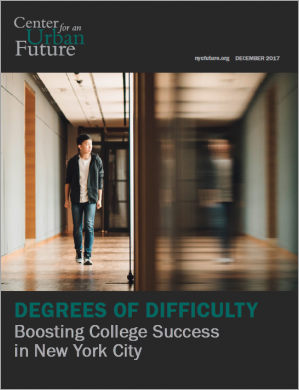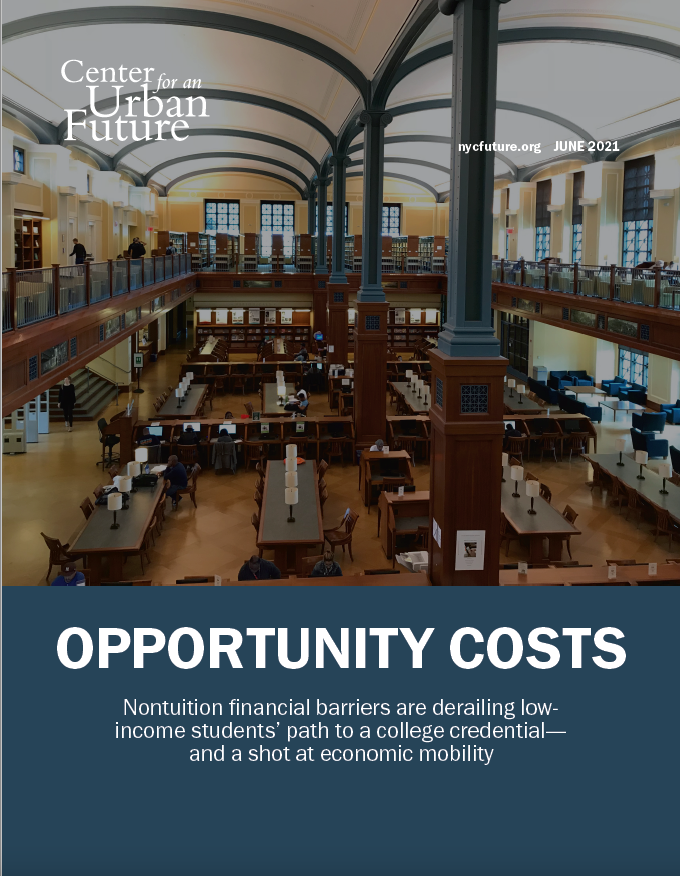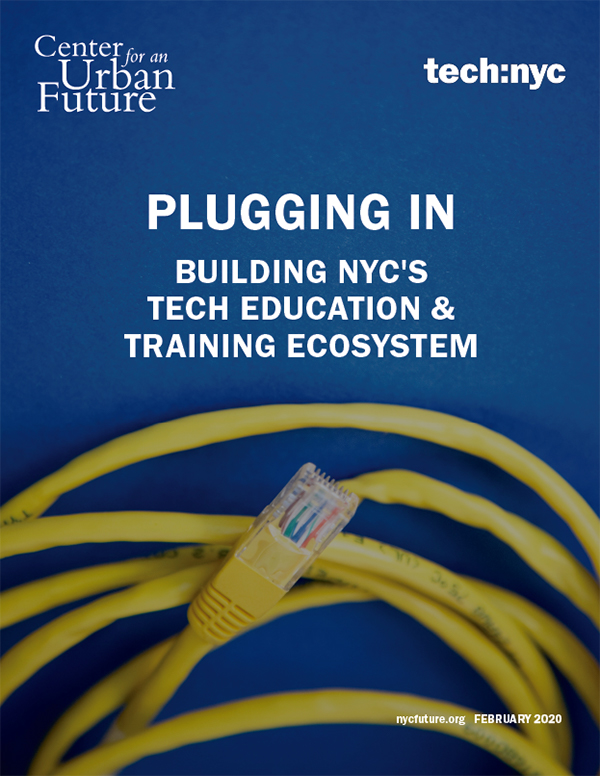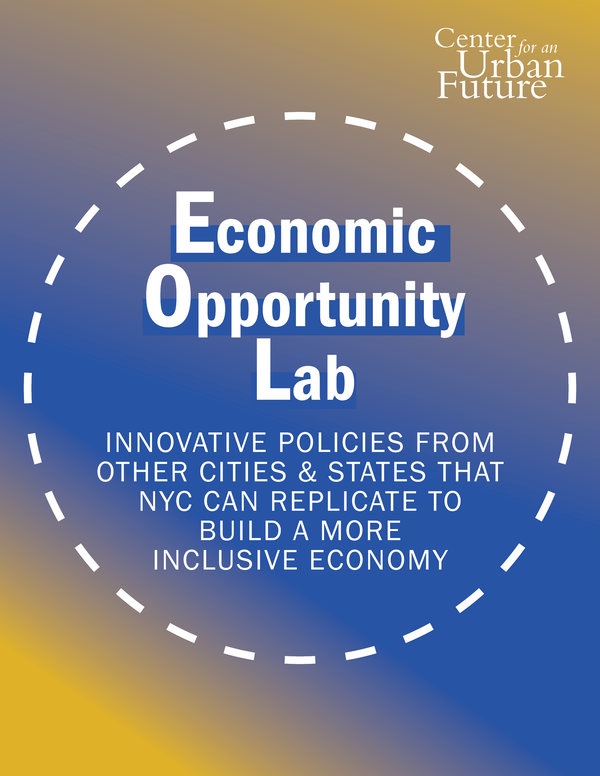New York City still has a major problem when it comes to college completion. Despite some clear improvements in high school graduation rates and college enrollment, far too few New Yorkers who enroll in college are graduating with a degree. This inadequate level of college completion is a longstanding problem, to the point where other issues often overshadow college success. Yet lagging student success in college is hurting the city’s ability to reduce economic inequality and expand opportunity, and this shortcoming will only deepen in the years ahead as automation and globalization reshape the world of work. If policymakers are serious about tackling inequality, then college success needs to become a top priority for New York.
New York has taken steps to begin meeting the challenge, but there is much more work to be done. To their credit, CUNY and DOE are implementing an array of innovative initiatives aimed at boosting college completion rates. But the status quo won’t change until the mayor and governor, city and state legislators, and education officials come together to make New York City’s college completion gap a top priority. A serious improvement in college success will take significant resources—not only in terms of funding, but in time, energy, and creativity. But the reward will be an unparalleled engine of economic mobility living up to its full potential.
FOR NEW YORK CITY AND STATE GOVERNMENT
Mayor de Blasio and Governor Cuomo need to make improving college success a top priority. Mayor de Blasio and Governor Cuomo have launched important new programs designed to reduce inequality and increase economic mobility—from raising the minimum wage to $15 an hour to implementing universal pre-kindergarten. Their next step should be to tackle New York City’s college success problem. Few other policy actions would have as great an impact on their common goal of getting more New Yorkers from low-income backgrounds on the path to the middle class. In today’s economy, most of the occupations that can provide middle-income wages and opportunities for advancement require a college degree. At the same time, an alarming share of New York City residents lack any form of postsecondary credential. And while a growing number of New Yorkers are enrolling in CUNY’s community and senior colleges, far too few are succeeding. Unless New York can dramatically strengthen college degree attainment for the low income New Yorkers who comprise the overwhelming majority of students at CUNY institutions, it will be difficult to significantly reduce inequality or expand economic mobility.
The state should establish a Student Success Fund for CUNY and SUNY. New York State is the largest funder of the CUNY and SUNY higher education systems, the recipient of tens of billions of dollars in annual tax revenues from college graduates, and the steward of a state economy powered by a college-educated workforce. The launch of the Excelsior Scholarship demonstrates the state’s commitment to expanding access to its public colleges. Over the years, however, the state has paid too little attention to the capacity of its public colleges and universities to graduate their students. That needs to change.
New York State should establish a Student Success Fund, enabling colleges to invest in boosting student success. Allowable uses of funding should include the action items identified in this report, such as expanding CUNY ASAP or testing ASAP-like models in the SUNY system; designing corequisite instruction models that bypass developmental education; developing guided pathways to reduce student confusion on the way to a degree; and exploring strategies to strengthen college advising, such as student peer counseling or text-message-based artificial intelligence assistance. A Student Success Fund could make New York a national leader in strengthening college completion— but only if it is guided by rigorous evidence. Colleges should be expected to use funding to build the evidence base around student success initiatives and to scale up strategies that the evidence supports. Student outcomes should be reported consistently and publicly disclosed, and interventions should be evaluated by third-party organizations. California has already created a competitive statewide grant program for developmental education reform. New York should learn from the Golden State’s example, but aim for a broader set of potential strategies to enhance student success.
Help low-income students overcome the non-tuition financial burdens that push many to drop out. Although CUNY and DOE can make important educational reforms that boost student success—from revamping developmental education to increasing the number of student peer counselors—city and state policymakers need to play a major role in addressing one of the biggest contributing factors to CUNY’s high dropout rate: non-tuition financial barriers. More than 70 percent of community college students at CUNY live in households that earn less than $30,000 annually. Even though CUNY’s colleges all provide a host of services for low-income students—such as food pantries for students who cannot afford lunch and Single Stop offices that connect eligible students to public benefits—financial hardship remains a constant struggle for the majority of CUNY students. The recently retired president of Kingsborough College, Farley Herzek, reports that as many as three-quarters of first-year students who dropped out within a year were struggling to pay college expenses. Although financial aid programs such as TAP, Pell, and now Excelsior help cover tuition for a significant number of CUNY students, up to two-thirds of the total cost of attendance is in non-tuition expenses. To increase student success, the city and state should direct resources toward the non-tuition expenses that burden low income students.
Provide free MetroCards for all full-time CUNY community college students. Mayor de Blasio could take a giant step to make college more affordable by funding free MetroCards for CUNY’s 58,000 full-time community college students. Doing so would help address one of the biggest—and least understood—reasons that so few of the students who enroll in CUNY community college make it to graduation: the cost of public transportation. Although the state’s Excelsior Scholarship program is intended to make college more affordable, this report points out that relatively few students in the five boroughs will benefit from that program. As we heard in our research, so many of the city’s community college students get tripped up by other non tuition costs, including the cost of transit, which CUNY estimates at more than a thousand dollars annually for full-time students. CUNY ASAP provides free monthly MetroCards to its participants, and that benefit has proven one of ASAP’s most popular features. ASAP has succeeded in more than doubling the three-year graduation rate of its participants in part by addressing college expenses that halt student momentum. It’s time to bring this important benefit to all of CUNY’s 58,000 full-time community college students.
Provide state funding to expand ASAP to all full-time associate’s degree students. CUNY ASAP is the nation’s most effective student success initiative, according to independent researchers, more than doubling the graduation rate of community college students that participate. Yet only a small share of CUNY’s community college students is able to benefit, due to limited financial support for the program. Although CUNY is now in the process of expanding ASAP to more than 25,000 students, this still represents fewer than half of CUNY’s full-time community college students. The governor and State Legislature should develop a funding source that would make ASAP a universal program at CUNY—and whichever SUNY institutions are willing to implement it. Some funding could come from merging the College Discovery opportunity program into ASAP, but state policymakers should be challenged to put enough dedicated funding on the table to make ASAP a wall-to-wall CUNY program.
New York State should overhaul the Tuition Assistance Program (TAP) to support college completion. New York’s need-based financial aid scholarship plays a vital role in helping low-income students afford college. Yet many compromises and choices were made in TAP’s design without proper consideration for how college students learn and build momentum to reach graduation. Here are four steps the state should take to align TAP with the best evidence on student success in college:
- Abolish TAP provisions relating to TAP-able credits. New York State’s financial aid grant, the Tuition Assistance Program, requires all courses beyond the general education level to be related to the student’s major. This “TAPable” credits requirement is supposed to incentivize students to complete their studies quickly. Instead, it causes students to lose TAP eligibility altogether. Countless students do not understand the provision or often even know about it, and neither do their advisors - a recipe for sudden disaster when the student enrolls in an ineligible course that causes their tuition load to fall below the minimum needed for TAP eligibility. Further, the provision itself is counterproductive in that it penalizes students for choosing a major early, and holds students responsible for taking major-related courses that may not even be available in a given semester. The state should simply legislatively repeal the requirements related to TAP-able credits.
- Expand TAP and Excelsior coverage to part-time study. State policymakers should expand TAP to the roughly 103,000 students attending CUNY on a part-time basis. These part-timers are now effectively barred from accessing the state’s TAP program, a serious flaw in the program that hurts many low-income students’ college aspirations. Although full-time study is far better than part-time study for maintaining academic momentum and should be encouraged, the reality is that tens of thousands of New Yorkers who recognize the importance of getting a college credential cannot set aside work and family responsibilities to attend college on a full-time basis. Moreover, when family or financial problems arise, many students that begin college full-time need to scale back hours for a semester. Doing so, however, typically causes the student to lose eligibility for TAP. Restrictions on the state’s current part-time TAP program should be lifted to improve flexibility, enabling students to stay with their college studies and relieving them of the need to take additional classes just to preserve TAP eligibility. Further, the state’s Excelsior Scholarship Program requires students to attend for 15 credit hours per semester to maintain eligibility, an unrealistic expectation given the financial demands on so many public college students. Excelsior should also be expanded to include part-time study, possibly by covering a certain number of credits rather than semesters of study.
- Expand TAP coverage to summer study. TAP covers college tuition during fall and spring semesters, but not the summer semester. As a result, most students take the summer off. But that’s not necessarily a good thing. When it comes to low-income college students, the motto of the organization Complete College America is right on target: “Time is the enemy.” The longer it takes to complete necessary classes and graduate, the more opportunities there are for family or financial emergencies to throw students off course. New York should expand TAP to cover full-year study, not just spring and fall semesters, so that students who want to can study year-round and graduate sooner.
- Increase the TAP maximum award to the level of tuition, but only for public institutions of higher education. The state has saddled CUNY and SUNY with the massive fiscal burden of covering the difference between the TAP maximum grant and the level of tuition paid at senior colleges. At CUNY alone, this cost amounts to $50 million annually—money it should be using to hire full-time faculty, improve student advising and expand innovative programs like ASAP and START. It would make sense to raise the maximum TAP grant to the annual tuition level, and then index it for future tuition hikes. But doing so for all colleges in New York would be prohibitively expensive. The state legislature should therefore break with tradition and raise the TAP maximum award only for CUNY and SUNY. While students at private colleges also deserve assistance, the reality is that students attending the colleges and universities chartered by New York State deserve special consideration.
New York State and New York City should collaborate to develop a work-study program for collegiate peer counseling.
Providing more student support does not always mean hiring new staff. One of the most effective interventions at both the high school and college level is peer counseling, in which high school students are trained to support other high school students and college students support other college students. They work 10 to 15 hours per week and are paid for their time. Both DOE and CUNY favor this model, which has shown positive outcomes, but it is limited by funding constraints. New York City should collaborate with New York State to launch a work-study program designed to fund peer counselors and house them within the high schools and colleges most in need of support. New York State should create a task force on college access and success. The state should convene a high-level task force composed of top leaders in the field as nominated by the governor and both chambers of the State Legislature. This task force could be modeled on the Michigan College Access Network (MCAN), which coordinates college access advocacy and technical support in communities across the state. MCAN has set an ambitious goal of achieving 60 percent college attainment for all adult residents of Michigan, and to achieve that goal it brings state and local stakeholders together to advocate for effective policies that support students. In addition, MCAN identifies and implements high-impact practices like promise zones, near-peer college advising, and a college application week—all approaches that New York State could adopt.
New York City should coordinate more effectively with community-based organizations. The city’s rich network of community-based organizations offers a powerful resource for supporting college access and success. A survey by Graduate NYC found upwards of 200 programs across the city providing a range of supports across their communities, from college exploration and campus visits to advice on financial aid applications to help connecting to assistance with degree planning and major selection, and much more. Yet the leadership of many of these community based organizations say there is little sign of a cohesive vision for weaving them into the support structure for aspiring high school and college students. That does not mean that DOE or CUNY are standing still. CUNY’s Strive for Success initiative enables community based organizations to train young people to become peer counselors at CUNY colleges, forging a point of contact between organization and college. DOE has built specific partnerships with leading organizations such as CARA and Goddard Riverside’s Options Center to provide needed services. But the city’s policymakers need to go further, by inviting the leaders of community-based organizations to whiteboard a more systematic structure of collaboration between DOE, CUNY, and the nonprofit community.
FOR THE NYC DEPARTMENT OF EDUCATION AND CITY HIGH SCHOOLS
Establish a full-time counselor at every high school to provide targeted support to all students in the college-going process. Testimony of professionals in the field and the best evidence from researchers converge on a paradigm shift that all high schools in New York City need to make: staffing a full-time college and career counselor. It is not that hiring or contracting for such a position ensures that students will achieve their college aspirations. On the contrary, building a college-going culture takes a village. Teachers, administrators, school counselors, and others play vital roles, and models will vary from school to school. But someone has to learn complex financial aid policies that no one else has time to keep up with. Someone has to build and leverage relationships with college admissions counselors. Someone has to provide individualized support to each student, not just the most obviously college-bound. These essential tasks cannot be done on a part-time basis, especially when college application season arrives and counselors are inundated with anxious students.
Many high schools lack a dedicated college access counselor. With a citywide average student-to-counselor ratio of 224 to 1 and numerous demands on counselors’ time, college access becomes just one of several balls they have to juggle. One approach might be to simply require high schools to hire a dedicated college access counselor. But this would invite paper compliance. Instead, DOE should take two steps that will move toward the goal. First, provide a funding stream for college access counseling, with the understanding that schools that already employ a full-time college access counselor can use the money creatively for a related purpose. Second, require high schools to report whether they have full-time staff carrying out the full-time college access counseling function, and publicly post the information for parents to see. That will enable the public to find out how seriously a given high school takes building a college-going culture and generate support from each school’s community of parents and students.
The city also needs more consistent training in college access counseling for the next generation of
school counselors. The Department of Education could offer preferential hiring for applicants who have college access training, and create externship slots for counselors in graduate programs to be mentored by school counselors experienced in college access counseling.
Expand the Office of Postsecondary Readiness and give it a leadership role in DOE’s college access initiatives. The Office of Postsecondary Readiness’s college access division is responsible for boosting college access and success in the New York City public school system. Until recently, however, the college access and success staff at OPSR consisted of only a handful of people. Even now, as the staff swells to 25, it remains too small to bring individualized services to the city’s 400-plus public high schools, and lacks authority to drive change beyond the specific initiatives it has been tasked with carrying out. DOE should develop the budget and staffing levels needed to provide sustained and effective support for the development of college-going culture in the city’s middle and high schools, as well as research and analysis into effective college access interventions.
OPSR should be the clearinghouse and coordinator for college access and success initiatives at DOE. While OPSR already plays a valuable role in professional development through its collaboration with Goddard Riverside’s Options Institute, the office should have the capacity to conduct extensive ongoing professional development for school counselors in college access counseling, comparable to that provided by affinity groups such as Urban Assembly and New Visions for Public Schools for the schools they support.
Leverage economies of scale in expanding access to rigorous college-preparatory courses. Students who take and pass rigorous college-preparatory courses—such as chemistry, physics, and precalculus— are more likely to succeed in college. Too few high school students take such courses, in part because many schools do not offer them. A lack of college-preparatory courses disproportionately affects the small high schools created during the Bloomberg administration. Yet attempting to add such courses to every single small high school could take years—especially given competing commitments to expand availability of computer science courses. Furthermore, the supply of teachers trained to use instructional techniques grounded in evidence on what helps young people learn is too small, and will also be a long-term project.
Instead, DOE should seek economies of scale. For example, many small high schools are co-located with other small schools or charter schools. It should be possible to offer college-preparatory courses—as well as other courses for smaller subpopulations, such as English language learners—for all schools co-located in a single building. Another strategy could be called a “hub-and-spoke” approach. For example, Board of Cooperative Educational Services (BOCES) schools are active in most counties outside New York City. They are funded and managed by school districts in their service area in order to provide educational services that span multiple school districts. DOE could replicate this approach by establishing a “hub” center to offer courses and programs of study that are not cost effective for individual schools to provide. Students in the “spoke” schools attend the center to take college preparatory courses relevant to their career aspirations. There are difficult issues to solve with such an approach, such as finding space for the center and providing convenient transportation so that getting to and from the center does not become an obstacle. But the reward would be equitable and cost-effective access to rigorous college-preparatory courses.
Yet another strategy would be to add new capacity to the College Now program, which already teaches college-preparatory courses to more than 20,000 high school students annually. However, the students who currently visit CUNY to take these courses are among the school system’s most gifted young people and are likely to enroll in college regardless. CUNY and DOE should consider adding new capacity for College Now to target services to students who lack college readiness. Offering a set of courses that can engage young people who read, write, or perform math below grade level would be a valuable service, and it would build on the services College Now already provides.
Overhaul math instruction in the city’s high schools. More than half of all first-year students entering a CUNY associate’s degree program—some 13,000-plus students—place into a remedial math course, and six in ten of those students drop out within the next two years. One key problem seems to be the city’s math curriculum, shaped in part by State Regents Examination requirements. Students do not take enough years of math to succeed in college, according to experts we interviewed; the senior year of math study is underutilized; and math curricula are aligned with the Regents math exams, but not with the CUNY math placement exam, thereby driving many students unnecessarily into math remediation courses. The State Education Department oversees the Regents math examinations and statewide graduation requirements. DOE should work jointly with the State Education Department and CUNY to align Regents math exams with credit-bearing math courses; encourage or incentivize students to take four years of math coursework, notably in the senior year; and provide more instruction in practical alternatives to higher-level algebra and pre-calculus, such as statistics and quantitative reasoning.
Advocate for collective-impact initiatives in high need communities throughout the city. The city’s wealth of community-based organizations are too disconnected and piecemeal in their approach to students and schools. New York urgently needs a comprehensive strategy to harness their enormous value. One promising approach is the collective-impact model, which brings stakeholders together to collaborate in solving large-scale social problems too intractable for any one organization or agency. Collective impact is strengthening educational reform in several communities, including Seattle, Cincinnati, and south Texas. In the Bronx, South Bronx Rising Together, Bronx Opportunity Network, and Here to Here are implementing a mode from which other high-needs communities can learn. DOE should encourage and staff the development of collective-impact collaboratives on a pilot basis in neighborhoods such as Brownsville / East New York, Harlem, and Corona.
Build capacity to evaluate the effectiveness of college access and success interventions. The city lacks crucial information on what interventions are most effective at improving students’ ability to get into college, afford college, navigate college culture, and graduate with a marketable credential. DOE already operates an effective in-house evaluation office, and works closely with the Research Alliance for New York City Schools. What is needed, however, is a top-level citywide agenda that aligns research, evaluation, and practice to compare the effectiveness of the most commonly used college access and success models and to develop new approaches as evidence emerges. The mayor should engage the Center for Economic Opportunity to bring in top national research organizations in collaboration with DOE, with external funding secured through the Fund for Public Schools to the extent possible. Armed with evidence-based practice models, the city can invest in partnering with organizations that use the most effective interventions to pilot new strategies and scale the approaches that work best.
FOR THE CITY UNIVERSITY OF NEW YORK AND PUBLIC COLLEGES
Expand the use of alternatives to remediation, notably fixing math remediation through college-level statistics with corequisite workshops. The track record of developmental education is a grim one. Students who test into developmental education in math or English must attend a community college (unless accepted into the SEEK opportunity program), and 85 percent of students enrolled at community colleges are placed into developmental education. Students taking remedial courses use up their financial aid without getting any closer to graduation, and they are far more likely to drop out than other students. Furthermore, test-based placement into developmental education is highly inaccurate: research shows that many of these students could have succeeded in credit bearing coursework, which could have kept them on the path to a degree.
CUNY has launched an ambitious reform that calls on community colleges to offer at least one alternative to conventional remediation. Math is especially overdue for a top-to-bottom overhaul, and CUNY has a promising evidence-based strategy to offer: a nonalgebra gateway course—such as statistics or quantitative reasoning—paired with weekly workshops (known as corequisite workshops) in which students can deal with concepts that give them trouble. Other colleges and states have found that this model produces remarkable gains in pass rates and college success. But CUNY’s community colleges need to embrace the statistics- plus-corequisite model and reorient their math remediation systems around it to achieve system-wide change. In the past, some math and English departments responsible for developmental education have shown little enthusiasm for reform. If that pattern repeats itself over the next several years, thousands of first-year college students each year will fall prey to wasted time and a far higher dropout risk.
Support student transfer from community colleges to senior colleges. Transfer students are the lifeblood of CUNY’s 11 senior colleges. In fall 2016, for example, half of senior colleges’ entering class of 36,587 undergraduate students were transfer students. Yet their progress toward a degree is too slow and uncertain. It is essential for CUNY to support student transfer more effectively. One effective strategy is to standardize acceptance of community college courses for credit at senior colleges, and in particular for credit toward the student’s major. CUNY needs more consistent and effective credit approval procedures that span all of its senior colleges.
CUNY ASAP provides another potentially promising route to support transfer students. Many students transfer from community colleges to senior colleges through the ASAP program, at which point all of the supports they received through ASAP lapse, leaving them to struggle through a new academic environment on their own. John Jay College is piloting a CUNY ASAP program for bachelor’s degree students called John Jay ACE. The city and state should support the scaling and replication of a bachelor’s degree version of ASAP, particularly for transfer students who participated in ASAP at their home institutions. The benefit to the city’s economy and CUNY’s degree production effectiveness would far outweigh the costs. One possibility would be to create an outcome-based funding stream, so that improved graduation rates are rewarded by higher funding levels.
Shift CUNY’s colleges and universities to a guided pathways framework. CUNY plays a vital role in offering higher education opportunities to young people who are the first in their family to seek a college education. Yet these students find navigating a college to be extraordinarily different. They face an alien culture and expectations, complex rules, tangled financial aid regulations, and unforgiving expectations, usually without any family members or close friends to ask for help. Too often they fall off track, signing up for a course that costs them financial aid eligibility or misunderstanding their major requirements.
Colleges across the country are developing guided pathways models that clarify the paths students can take to graduation day, with promising results. Guttman Community College already uses a guided pathways approach, as does CUNY ASAP. CUNY has already endorsed guided pathways at the systems level by agreeing to partner with Complete College America to develop a strategy. But the rubber will hit the road at the 17 campuses that have yet to transition to guided pathways. CUNY should build a template to facilitate the process by which most if not all of its colleges and universities can migrate to a career pathways framework. The city and state, as well as the philanthropic community, should explore funding opportunities that will help individual colleges manage start-up costs.
Develop more employer-recognized, credit-bearing non-degree programs at community colleges. In an ideal world, most community college students would be able to attend school full-time, accumulate transferable credits, and ultimately graduate from a senior college with a bachelor’s degree. But for students facing financial burdens, family obligations, and other challenges, CUNY needs to offer other options, too--options like certificates and certifications that cost far less in terms of both time and money while increasing employment opportunities and ultimately building a path to a degree. The most effective bridge between certificates and degrees is an agreement to allow courses in a certificate program of study to count for college credit if the student later enrolls in a degree-seeking program. Some programs, such as Borough of Manhattan Community College’s IT Career Pathways program and Bronx Community College’s Community Health certificate program, are “stackable” in this way.
Yet stackable programs are few and far between in the CUNY system. CUNY should work closely with industry partners, including employers and unions, to develop employer-recognized credentials that stack toward a degree. These credentials could form a crucial link in the chain from occupational coursework to graduating with a two- or even a four-year degree. In addition, New York State should provide partial subsidies to certificate and certification programs if they are stackable toward a degree and meet certain minimum standards.
Develop an artificial intelligence assistant to reduce summer melt and support advisors. Georgia State University (GSU) has achieved a powerful breakthrough that points the way for CUNY and other New York colleges. GSU faced a common problem called summer melt, in which students are admitted, commit to attending, and then fail to enroll—not just at GSU, but at any college. GSU has tracked summer melt rates as high as 18 percent. In response, researchers working with the college developed an artificial intelligence assistant they dubbed Pounce to send texts to admitted students’ cell phones. The texts provided information to students on milestones they had yet to complete, such as submitting their financial aid form to the federal government, submitting a high school transcript to the college, and RSVPing for orientation. The program was highly successful, reducing the workload for advisors and cutting the summer melt rate significantly.90 CUNY should use a virtual assistant like that used by GSU. If it proves successful, the virtual assistant could be trained to support colleges with other tasks, such as financial aid and career services advising.
Reform the Office of the State Comptroller’s approach to TAP audits. CUNY students who lose TAP eligibility are often driven out of college, unable to foot the tuition bill. This problem is far more prevalent than most New Yorkers realize due to the complexity of TAP’s eligibility and benefit rules. Harsh audits by the Office of the State Comptroller exacerbate the issue by forcing financial aid administrators to adopt a legalistic compliance mentality with students, either suddenly depriving them of financial aid or forcing them to choose courses solely to maintain TAP eligibility. To be sure, the State Comptroller has a fiduciary duty to provide oversight of this major financial aid program. But the office needs to focus on safeguarding against bad actors without punishing students—or college administrators acting in good faith.
The Office of the State Comptroller should adopt more restrictive criteria for launching audits, and use them as correctives rather than opportunities to confiscate college revenues. In addition, the State Education Department should convene a working group— including representatives from OSC, HESC, SUNY and CUNY financial aid offices, and community-based organizations—to identify changes to TAP regulations that can help more students succeed, develop clear guidance for all rules and regulations, establish appropriate training for TAP certifying agents, and help colleges and CBOs adopt best practices to maintain compliance.
90. Lindsay Page and Hunter Gehlbach, How an Artificially Intelligent Virtual Assistant Helps Students Navigate the Road to College, March 2017.











